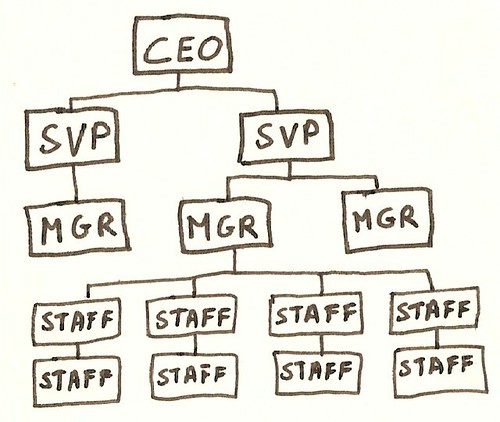Our tendency to ignore the invisible parts of an organization chart can lead us to the wrong conclusions about what success really is.
What You See
When I ask customers to give an overview of the way things are done in their organization, they typically end up showing me their organization chart. Instantly, the most logical question to ask seems to be: ‘Which position is most important in order to get things done over here?‘

There are three types of answers:
- The CEO: those who favor this position as ‘most important’ tell me that this is the person who has the authority to get things done and who carries the vision to inspire the troops;
- The frontline people at the bottom of the organization chart: the argument here is that you can change all you want, but if these people are not committing to your goals you might as well forget it;
- Middle Management: logically, if they are unable to get it all organized, the initiative will fail big time.
So there you are: three different answers, all alike in justification.
What You Get
The truth is that there is no telling which position on an organization chart is most important in order to get things done. That is because the question is a trick question. The real question is: ‘Without looking at that chart, what are the ingredients for success?’.
Last week I had the chance to ask that question to a manager of an organization with a lot of sites on different geographic locations. From his experience, the most successful projects in the history of his organization were those where the project manager could gather a team of competent and complementary talents who were working in a relationship of trust. The most important part is that these teams constantly kept in touch with the hierarchy.
This means that the most important part of the organization chart is not the positions (‘the boxes’) or the reporting lines. It is the white space between them.

What this manager was telling me is something we all know from our intuition: it is not the number of degrees of a project manager that determines the success of a project. Rather, it is the extent to which this person is able to recruit a network of people from the hierarchy and put them in a social fabric that fosters a community for co-creation.
In other words: successful project managers are social architects. They provide a platform on top of the hierarchy, allowing the community of ambassadors to realize the objectives of the project. So here is an alternative definition of a social architect:
A Social Architect is someone who makes conscious use of the white space on an organization chart.
Stay tuned , for this is not the last word on this subject.


Pingback: The Map of Compliance & Community | Reply-MC()